There are certain words that just don’t translate. Some of those words are original Italian words that we English speakers have adopted into our own language. This is especially true when we talk about Italian food. Many of the words we accepted into the English language still have the same meaning as the original Italian. A few words have mutated over the years into having their own unique definition unequal to the original. In some cases, English speakers pronounce these Italian words fairly well, albeit with our own native accents applied. Other words, even we cannot agree upon a single “English-ified” pronunciation. Let’s take a few minutes to note the 30 most popular Italian food words used in English.

1. Arancini
English meaning: Delicious fried rice balls
Plural: arancini or arancinis
Italian meaning: rice balls originating from Sicilian cuisine
Plural: arancini
The singular word we use in English is actually the Italian plural. The Italian singular form is arancina or arancino (depending on the region).
IPA: /aran-tʃi:-ni:/
2. Biscotti
This tasty word shares an origin with the British-English word “biscuit”.
English meaning: a dense, twice-baked, oblong-shaped, almond cookie, often sold at coffee shops or meant to be dunked into dessert wines
Plural: biscotti or biscottis
Italian meaning: cookies, usually twice-baked.
Plural: biscotti
Once again, the singular word we use in English is the Italian plural. The Italian singular is biscotto.
IPA: /bi-skɔtti:/
In some regions, particularly the town of Prato in Tuscany, the biscotti Americans picture is called cantucci or cantuccini.

3. Broccoli
English meaning: a green vegetable
Plural: mass noun but you will hear broccolis
Italian meaning: the same as in English
Plural: broccoli
The word we use in English is the Italian plural. The Italian singular is broccolo.
IPA: /brɔl-ko-li/
4. Bruschetta
English meaning: toasted bread topped with olive oil, garlic, and very often diced tomatoes and cheese. Sometimes, the prepared combination of olive oil, garlic, and diced tomatoes alone is called “bruschetta”.
Plural: mass noun but you will hear bruschettas
Italian meaning: an appetiser of toasted bread with fresh olive oil
Plural: bruschette
IPA: /bru-sketta/
Compared to the English pronunciation, which features a /sh/ sound, the original Italian word is pronounced with a /sk/ sound. Find out more about the pronunciation of bruschetta here.

5. Calzone
English meaning: a pizza-like dish, in which a pizza is folded over to create a turnover or pocket prior to baking
Plural: calzones or calzoni
Italian meaning: a folded pizza, baked in an oven, shaped like a crescent
Plural: calzoni
IPA: /kal-tzo-ne/
In English, the final “e” in “calzone” is silent. In Italian, all final vowel sounds are pronounced. In this case, the final vowel is pronounced with an “eh” sound. Find out more about the pronunciation of calzone here.
6. Carbonara
English meaning: a pasta sauce made with eggs, cream*, and bacon (or pancetta), also the pasta dish itself
Plural: carbonaras
Italian meaning: a pasta sauce made with eggs, black pepper, cheese, and guanciale (or pancetta)
Plural: carbonare (although I can think of very few situations in which you would ever use the plural form of the word)
IPA: /karbo-na-ra/
*American foodies get into heated arguments about whether or not cream should be an ingredient in carbonara.

7. Ciabatta
English meaning: a white bread often used when making a panini
Plural: ciabattas or ciabatte
Italian meaning: a white bread, similar to the French baguette
Plural: ciabatte
IPA: /tʃa-batta/
The “ci” combination in Italian makes a /ch/ sound. Find out more about the pronunciation of ciabatta here.
Fun fact: “Ciabatta” has three different meanings: this delicious bread, as well as “slipper” and “power strip”.
8. Espresso
English meaning: an Italian type of coffee, often available as additional “shots” to your favorite coffee beverage at chain coffee shops
Plural: espressos or espressi
Italian meaning: the standard coffee, drank alone in a tiny cup, or mixed with milk or foam to make a macchiato or cappuccino
Plural: espressi
IPA: /e-sprɛsso/
Because the espresso is the norm for coffee options in Italy, Italians typically don’t refer to the beverage as an espresso. Instead, they will simply say caffè, meaning coffee. If you want two shots of coffee in your mug, you can ask for a double espresso or a caffè doppio.

9. Focaccia
English meaning: an oily, often fluffy, Italian bread. It is usually made in the shape of a rectangle.
Plural: focaccias
Italian meaning: a thin, oily bread, similar to pizza crust. It is a favorite bread for building a sandwich.
Plural: focacce
IPA: /fo-kattʃa/
This word can be difficult to pronounce for many English-speakers. The 3 separates Cs each need to be pronounced, although the final “ci” combination is not pronounced as K, but like the English CH instead. You can find out more about the pronunciation of focaccia here.
10. Gelato
English meaning: a rich type of ice cream of Italian origin.
Plural: gelatos
Italian meaning: ice cream. This word is used to mean any type of ice cream, no matter the country of origin.
Plural: gelati
IPA: /dʒe-la:to/

11. Gnocchi
English meaning: a type of Italian pasta* made with potato flour, typically formed into tiny lumps.
Plural: gnocchi or gnocchis
Italian meaning: a type of dumpling* made with potato flour.
Plural: gnocchi
Most pasta words are typically said in the plural. The singular form, in case you ever need to mention a singular piece of pasta that fell on the floor, is gnocco.
IPA: /ɲɔkki/
There are two separate consonant combinations that tend to confuse English-speakers, lending to many different pronunciations in English-speaking countries. However, the Italian pronunciation is simple. The starting “gn” combination makes a /ɲ/ sound, similar to the Spanish “ñ”. The ending “chi” does not make a CH sound; it makes a KI sound, like in the English word “key”. You can find out more about the pronunciation of gnocchi here.
*Is gnocchi a type of pasta or dumpling? Great question. The debate continues amongst foodies around the world.
12. Lasagna / Lasagne
English meaning: a long, flat pasta noodle, used for making a particular dish featuring the noodles layered with ragù (a sauce made of ground meat and tomato) and cheese. Also, this word is also the name of the dish mentioned above.
Plural: lasagnes, lasagnas, lasagne
Italian meaning: the same as in English
Plural: lasagne
Like most pastas, Italians typically refer to lasagna in the plural (lasagne). This is one of the few cases in which English-speakers may use the singular instead of the plural.
IPA: /la-zaɲa/
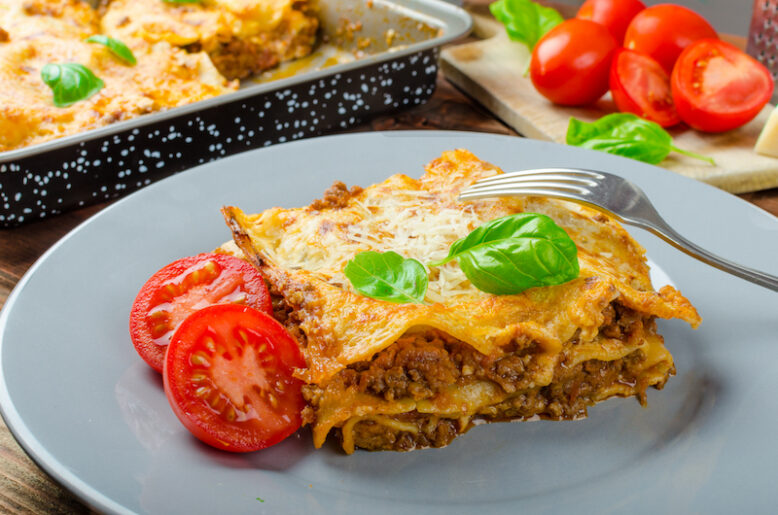
13. Latte
English meaning: a coffee drink made from mixing espresso with steamed milk.
Plural: lattes
Italian meaning: milk
Plural: latti
IPA: /latte/
When traveling to Italy, if you want a taste of your favorite Starbucks latte, you will need to instead ask for a caffè latte (espresso mixed with a splash of milk) or latte macchiato (milk mixed with a splash of espresso). The difference here depends on the ratio of espresso to milk.
14. Minestrone
English meaning: a vegetable-based soup of Italian origin.
Plural: minestrone or minestrones
Italian meaning: a hearty soup made up of whatever vegetables are on hand, sometimes including meat, pasta, or rice.
Plural: minestroni
IPA: /mine-stro:ne/
The pronunciation of minestrone by most English-speakers is neither correct Italian nor appropriately English-ified. Typically, we pronounce this word with a strong “ee” sound at the end, as if we are saying the name of the final letter. This does not coincide with traditional English phonics, nor is it the original Italian pronunciation. In Italian, it is pronounced with a “eh” sound.

15. Mozzarella
English meaning: a type of white cheese that is a favorite topping on pizzas. It is usually made from cow’s milk.
Plural: mozzarella or mozzarellas
Italian meaning: a type of white cheese, typically high in moisture, that is popular on pizzas and in a caprese salad. This cheese is usually found in a ball shape. It can also be made from buffalo’s milk.
Plural: mozzarelle
IPA: /mottsa-rɛlla/
The biggest difference between the English pronunciation and the Italian pronunciation is the opening “o”. In English we tend to pronounce it with an open “aw” sound, whereas in Italian it is pronounced as an “oh”.
16. Panettone
English meaning: an Italian imported Christmas fruitcake.
Plural: panettone or panettones
Italian meaning: a favourite Christmas treat, similar to a fruitcake, shaped like a cylinder with a dome top. Most Italians prefer to simply buy it boxed from a supermarket over making their own.
Plural: panettoni
IPA: /panet-to:ne/
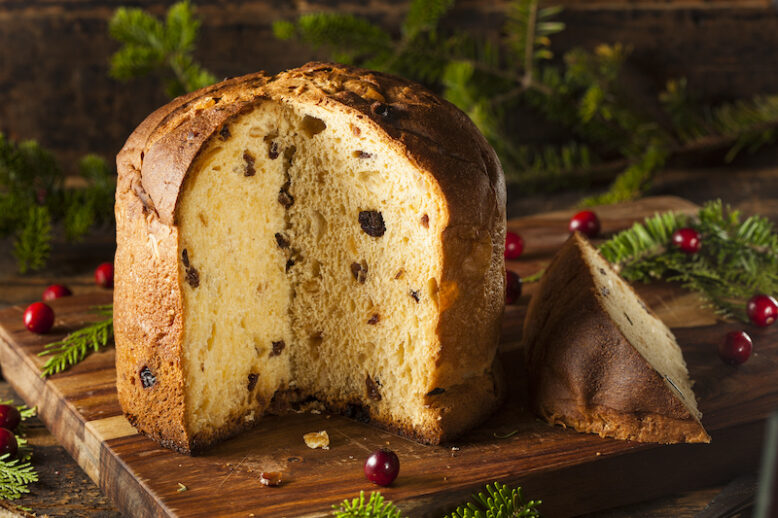
17. Panini
English meaning: a type of sandwich served on Italian bread (often ciabatta) and toasted by a machine called a Panini Press.
Plural: panini or paninis
Italian meaning: sandwiches, of any type or origin.
Plural: panini
This is another case in which English-speakers have adopted the Italian plural as our English singular. The Italian singular form is panino.
IPA: /pa-ni:ni/
Because panini simply means “sandwiches”, it can be used to refer to pretty much any type of sandwich. Two turkeys on rye are panini. Two toasted prosciutto on ciabatta are panini. The only exception is the tramezzino which is a specific kind of triangular Italian sandwich constructed from two crustless slices of white bread.
18. Parmesan (Parmigiano)
English meaning: a delicious, aged, hard cheese of Italian origin.
Plural: parmesan or parmesans
Italian meaning: the same as in English. However, it is also called Parmigiano Reggiano, referring to the fact that one particular variation of parmesan originates from Parma and Reggio Emilia.
Plural: parmigiani or Parmigiani Reggiani
IPA: /parmi-dʒa:no/ or /parmi-dʒa:no red-dʒa:no/
Italians take their certifications of origin very seriously. They are proud of the delicacies that make each region unique. For this reason, there are a lot of laws involved in which cheeses can be called what name, according to the origin of the ingredients and the production.
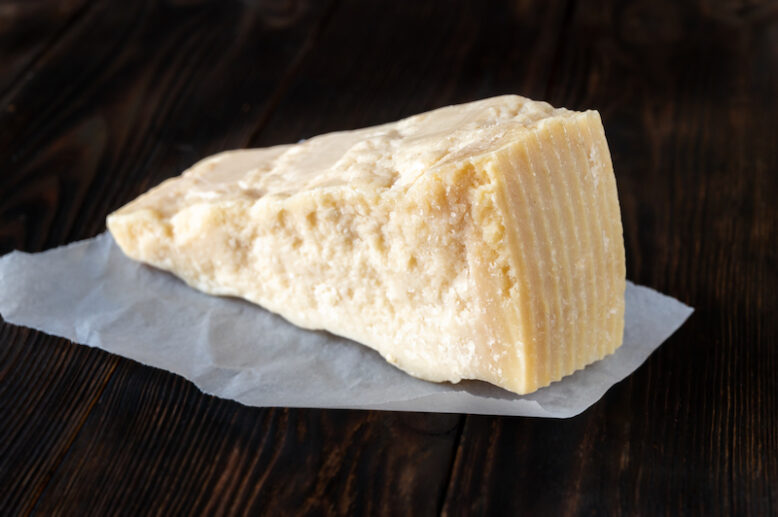
19. Pasta
English meaning: a dish of Italian origin using noodles and sauce, occasionally with meat or vegetables. Or can simply refer to the Italian noodles used in the dish of the same name. There are many variations.
Plural: mass noun but you may hear pastas
Italian meaning: the same as in English
Plural: paste
IPA: /pasta/
Fun fact: There are more than 300 different forms of pasta, based on ingredients, shape, or if they are freshly-made or dried. What’s more, some of these different forms go by different names based on the region. In total, there are more than 1,300 different names for various pastas.
20. Pepperoni (Peperoni)
English meaning: a spicy salami made from cured pork and beef. It is a favorite topping on pizza.
Plural: mass noun but you may hear pepperonis
Italian meaning: not applicable. The word peperoni (note that this word has one less “p”) means “bell peppers”. This is a plural word. In its singular form, it is called a peperone.
“Pepperoni the Salami” is not Italian. It is actually of Italian-American origin. Thus, Italians have no concept of pepperoni by that name. Instead, they would sooner call it salame piccante.
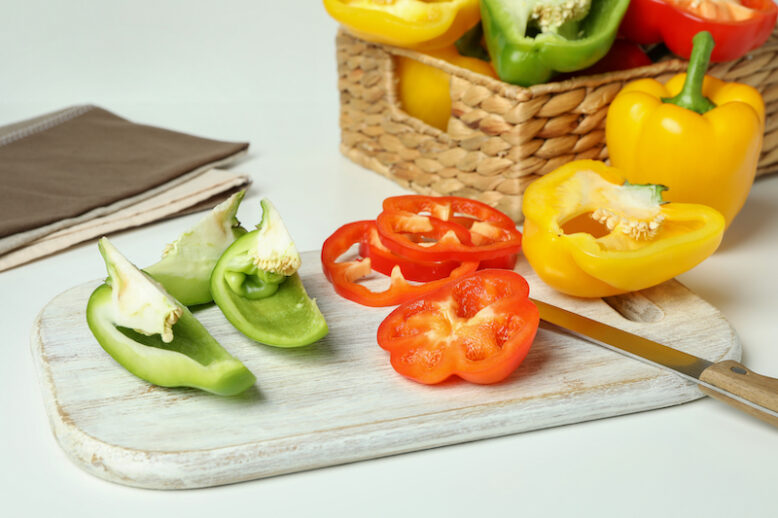
21. Pesto
English meaning: a sauce made from pine nuts and basil.
Plural: mass noun but you may hear pestos
Italian meaning: the same as in English.
Plural: pesti
IPA: /pesto/
Pesto originates from the city of Genoa, in Liguria, Italy. Because of this, Italians all across the country consider pesto alla Genovese (“pesto from Genoa”) to be the pinnacle of quality.
22. Pistachio (Pistacchio)
English meaning: a green coloured nut
Plural: pistachios
Italian meaning: the same as in English.
Plural: pistacchi
IPA: /pistak-kio/
In English, we pronounce the ending of this word with a SH sound, as in “she”. In the original Italian, the “chi” creates a K sound instead, as in “key”. Also, please note that in Italian, it is spelled with an additional “c”. You can find out more about the pronunciation of pistacchio here.
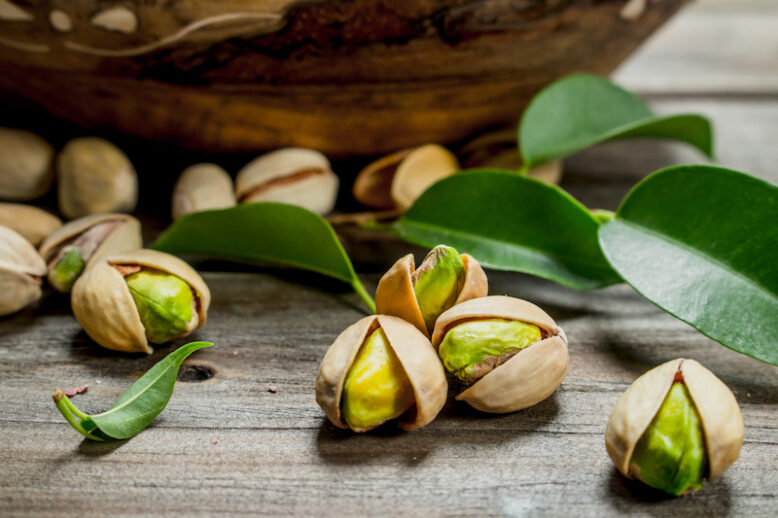
23. Pizza
English meaning: a dish of Italian origin consisting of leavened dough covered with tomato sauce and various toppings. Often served cut into triangular slices.
Plural: pizzas
Italian meaning: a dish consisting of rounded leavened dough covered with toppings of choice. Often served whole, cooked to be a single serving.
Plural: pizze
IPA: /pittsa/
A lot of the most common American pizza toppings are uncommon in Italy. Margherita is one of the true Italian staples.
24. Prosciutto
English meaning: thinly sliced dry-cured ham.
Plural: prosciutti or prosciuttos
Italian meaning: ham.
Plural: prosciutti
IPA: /proʃ-ʃutto/
Italian prosciutto is served one of two ways. Prosciutto crudo (meaning “raw”) is dry-cured; this is what most Americans picture when they think of prosciutto. Prosciutto cotto (meaning “cooked”) is cooked.

25. Ragù
English meaning: a sauce made with minced meat, onion, tomato puree and red wine, served with pasta, usually spelled ragu without the accent
Plural: mass noun
Italian meaning: same as the English meaning
Plural: ragù (there is no formal plural term)
IPA: /ra-gu/
Americans and Brits alike adore the idea of a genuinely authentic Italian plate of Bolognese (Bolognaise). Unfortunately, native Italian are unfamiliar with this supposedly “Italian” dish by that name alone. In Italy, this famous dish is a special variation of ragù, as made in Bologna. If you want an authentic plate of Bolognese, you’ll have to ask your waiter for pasta con ragù alla bolognese.
26. Ravioli
English meaning: a type of stuffed pasta, usually cut to be a square shape
Plural: ravioli or raviolis
Italian meaning: the same as in English, although the shape may vary between squares or circles
Plural: ravioli
This word is already in the plural form, because very seldom do we cook a singular raviolo for a meal.
IPA: /ravi-ɔli/
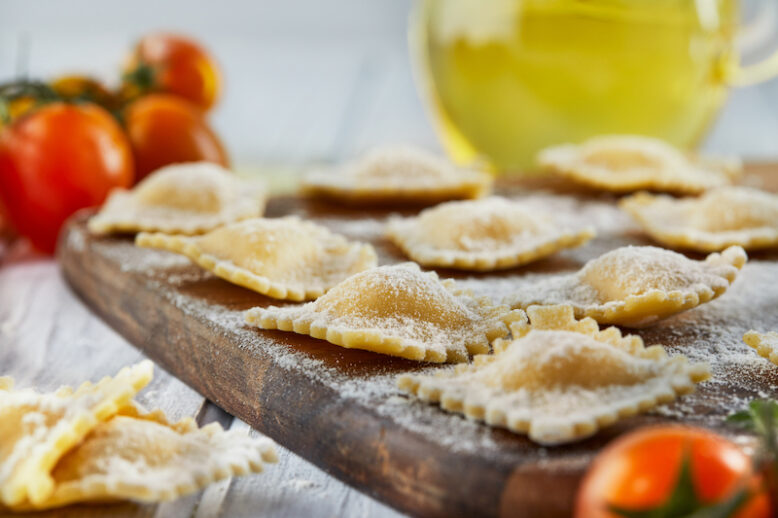
27. Risotto
English meaning: a dish featuring cooked rice of Italian origin.
Plural: risottos
Italian meaning: a dish of rice cooked in broth, often with various add-ins
Plural: risotti
IPA: /ri-zɔtto/
28. Spaghetti
English meaning: a type of pasta noodle that is a long, narrow rod. Also the shortened name for “spaghetti and meatballs”, an Italian-American dish featuring spaghetti noodles, ragù or tomato sauce, and meatballs.
Plural: mass noun but you may hear spaghettis
Italian meaning: a type of pasta noodle that is a long, thin rod.
Plural: spaghetti
Like most pasta noodle words, this word is already in plural. The singular form would be spaghetto.
IPA: /spa-getti/

29. Tiramisu (Tiramisù)
English meaning: a dessert of Italian origin consisting of coffee-dipped ladyfingers layered in a sweet mixture with mascarpone cheese
Plural: tiramisu or tiramisus
Italian meaning: the same as in English. Sometimes the ladyfingers are dipped in a coffee-flavoured liqueur.
Plural: tiramisù
IPA: /tirami-su/
Fun fact: this dessert’s name literally translates to “pick-me-up”, which is exactly what this treat is: a little pick-me-up that is sure to put a smile on your face!
30. Zucchini (Zucchine)
English meaning: a green vegetable
Plural: zucchini or zucchinis
Italian meaning: the same as in English.
Plural: zucchine / zucchini
The singular form in English is zucchini. In Italian, the singular form can be either zucchino or zucchina and their respective plurals are zucchini and zucchine. Zucchino is the older form found in many dictionaries, but zucchina tends to be the preferred form in everyday speech in many regions.
IPA: /zu-ki-ni/

Additional reads:
- 15 Commonly Mispronounced Italian Food Words
- How to Order Food in Italian at a Restaurant
- 10 Words & Phrases to Describe Good Food in Italian
- 50 Common Italian Words Used in the English Language
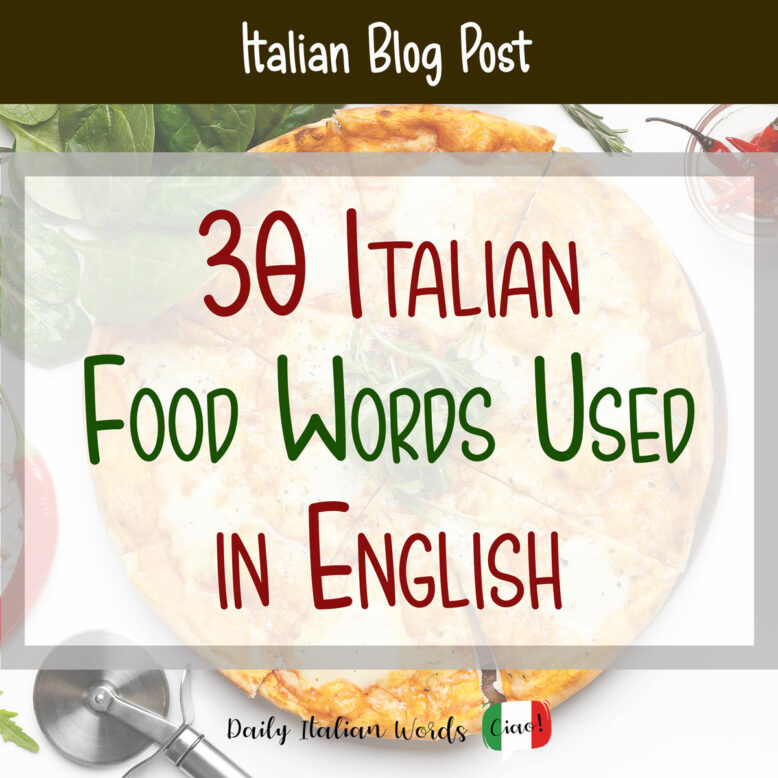

Heather Broster is a graduate with honours in linguistics from the University of Western Ontario. She is an aspiring polyglot, proficient in English and Italian, as well as Japanese, Welsh, and French to varying degrees of fluency. Originally from Toronto, Heather has resided in various countries, notably Italy for a period of six years. Her primary focus lies in the fields of language acquisition, education, and bilingual instruction.


